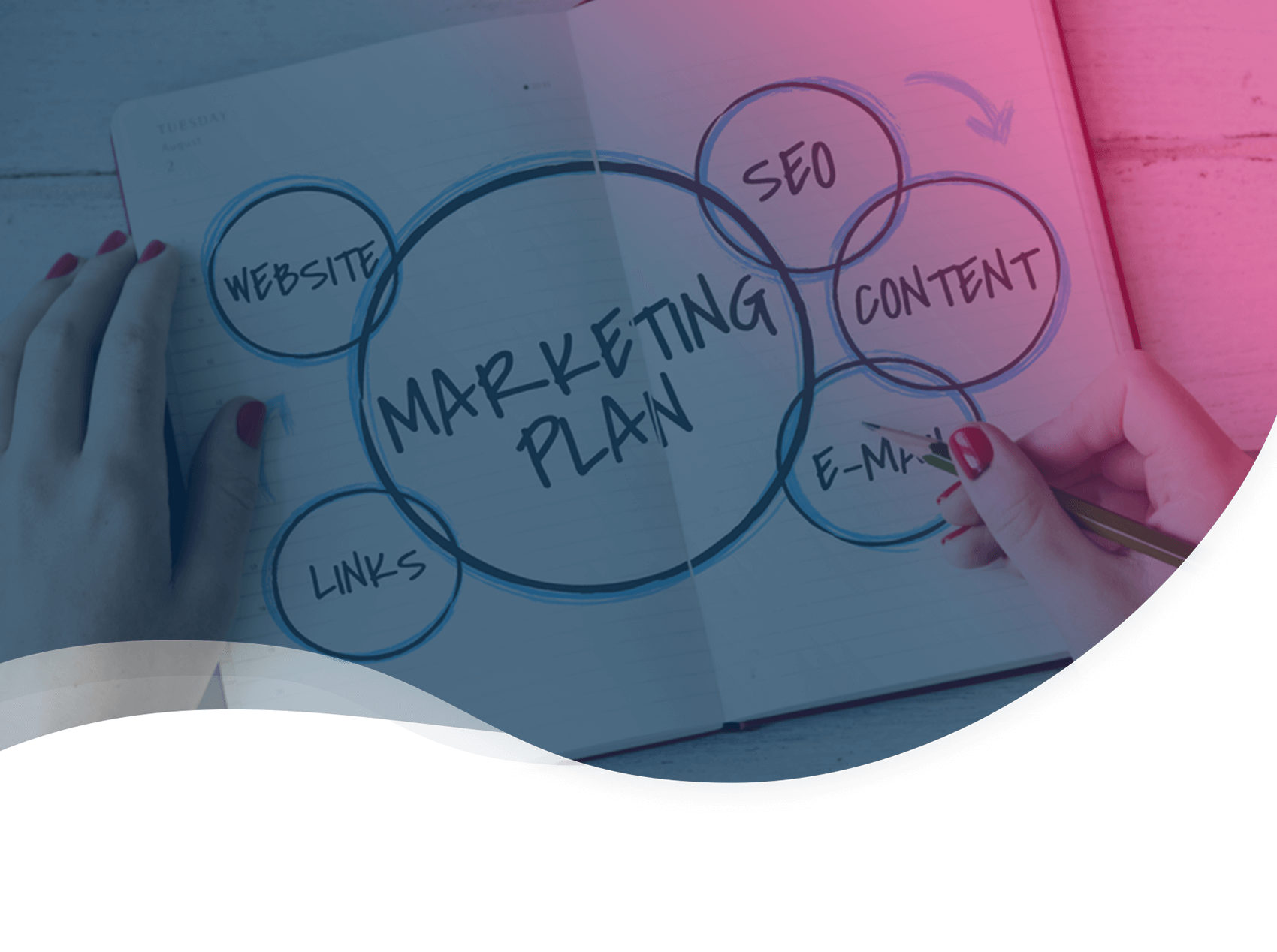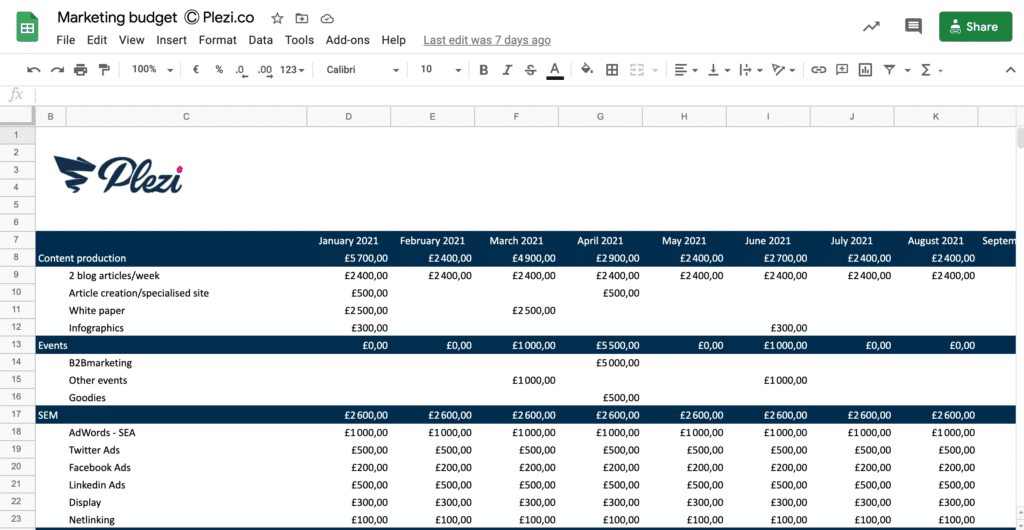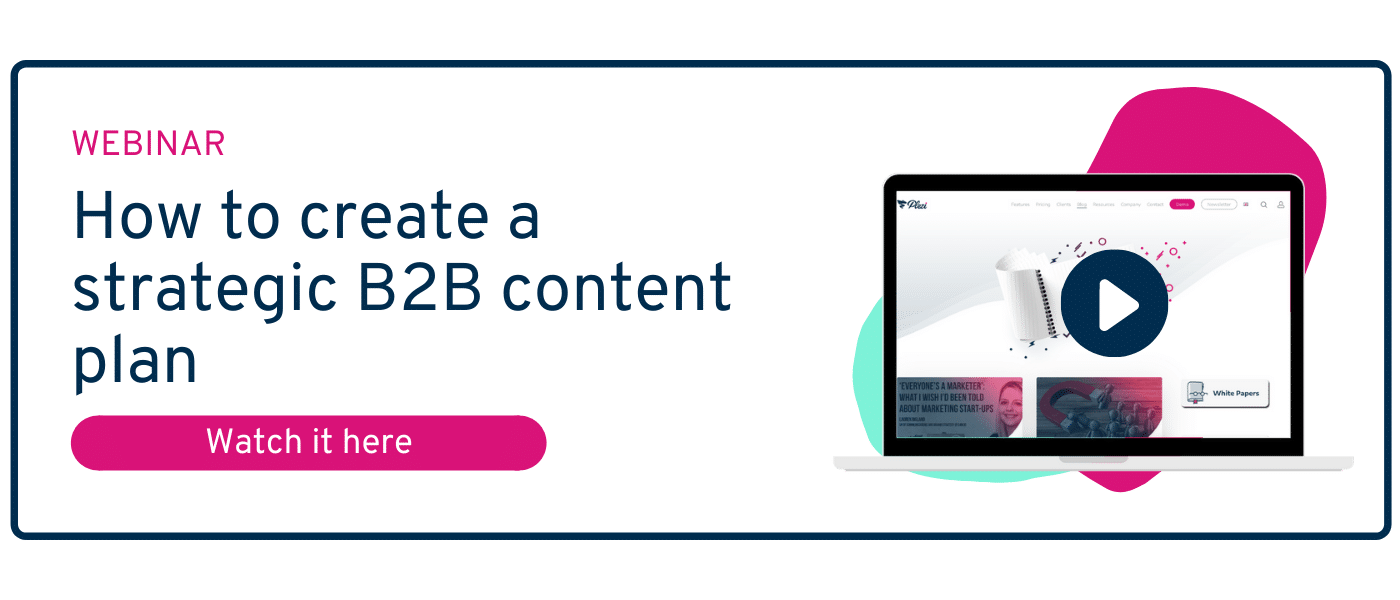A marketing plan is a document that details all of the actions to be carried out over a given period of time to achieve your marketing objectives. It turns your B2B marketing strategy into specific actions that each have a time frame.
A marketing plan provides clear and tangible answers to the following questions:
- What actions need to be taken?
- By whom?
- When?
- How? Using which human, financial, and physical resources?
Developing a digital marketing plan helps to structure the work of the marketing team and to ensure that marketing campaigns and strategies are consistent with each other. Your aim is to improve the reach to your audience and future buyers, but also to look at the particular strategies that work for your company in order to increase business for your services. In this article, we’ll look at the steps you should follow to create a marketing plan that’s truly effective for your business.
1. Define your marketing targets
To create a marketing plan that you have confidence in, you need to start by setting some SMART objectives (Specific, Measurable, Achievable, Realistic, and Time-based). These can be both qualitative and quantitative targets.
For example, “increasing sales” is not a SMART objective. But a SMART objective could be to “increase sales revenue by 30% in the next 6 months.”
Generally speaking, your marketing targets will be based on the strategic targets set by the executive team, in particular those relating to turnover or sales. It is also important to ensure that your marketing targets are aligned with the company’s sales goals.
To set your marketing targets then, you can then work backwards from the strategic targets taking into account a number of key indicators: Customer Lifetime Value, customer acquisition cost, and your conversion rates or, if you don’t yet have data for these, the average conversion rates for your business sector.
Let’s say that, based on these indicators, you see that you need to find 30 new customers in the given period.
If you know your conversion rates, you can use the predictable revenue model at each stage of the marketing funnel and set objectives for SQLs, MQLs, leads, contacts, and website visitors.
2. Create your buyer personas
To meet your strategic marketing targets, you need to ensure that all of your marketing actions are geared towards a specific target audience.
You can get to know just who your potential customers are by defining your buyer personas.
This doesn’t just mean targeting them according to their role, type of company, or level of turnover. Instead, it means familiarizing yourself with your target customer’s day-to-day routine, understanding what they need, the challenges they face, and their problems in order to provide them with meaningful solutions. It is essential that you know your audience, what they want, their needs – so you can turn them into buyers of your product.
This exercise of creating buyer personas is absolutely essential because they should guide all your content marketing or inbound marketing actions. Re-examine how you view customers by talking to a select group of both customers and prospects to reveal the key bits of information you should be aware of.
Of course, if you already have a content marketing strategy in place, you should have already created your buyer personas. But these personas needn’t be set in stone. The problems and challenges your audience face can easily change. So, it’s a good idea to regularly review them. Sometimes it also makes sense to add a new buyer persona to your marketing plan. At Plezi, for example, we decided to include an “executive” buyer persona in our latest marketing plan.
3. Identify drivers
To start with, you defined your marketing objectives. Now, you need to identify the relevant drivers needed to achieve each of these objectives.
It’s a good idea to start this process by holding a workshop to take stock of the period that has just ended. Among the various drivers you used, what worked and what was a flop?
By using digital data to inform your thinking, this workshop will help you identify those drivers that were effective for your strategies.
But before throwing out those that didn’t deliver the expected results, you should assess whether you have in fact made the best use of them. For example, if you tried Google Ads with disappointing results, it might not be the driver itself that’s at fault but your wording of the ads themselves.
At the end of your brainstorming session, you can classify the different drivers into 3 categories: those you should continue using, those you should stop using, and those you should start using. The last category is made up of new drivers that you haven’t yet tried, but which seem likely to help you meet the objectives you’ve set.
To complete this step, you need to match your objectives to the corresponding drivers needed to achieve them. If one of your objectives is “increase website traffic by 50% within 6 months”, the drivers needed to do this, for example, might be SEO, SEA, content marketing, link building, and social networks.
To finish, you should set quantifiable targets for each driver you have listed and define key performance indicators. For example, for SEO, this might be “increase organic website traffic by 50%”.
4. Define key actions
Once you’ve identified what drivers to use, it’s time to get down to specifics and list the key operational marketing actions to carry out and marketing tools for each driver.
Again, you might choose to continue using some of those things that have previously worked well for your company. While others might be included in your marketing plan for the first time to meet new objectives.
For example, at Plezi, we set ourselves the objective of increasing our conversion rates by 5%. We identified that premium content was one of the digital drivers needed to achieve this. For the “premium content” driver, we set ourselves a new target: to publish premium content twice as often.
Among the key actions we needed to implement, we could continue to publish case studies as we had been doing but also decide to implement new actions, like creating webinars. The key action could therefore be “create 6 webinars during the year”.
Adopting an approach based on the sequence of objectives – drivers – key actions will give you an overview of the actions to be carried out and the reasoning behind these. This approach also lets you involve all stakeholders in the company in the process of achieving the objectives.
5. Organize actions
Marketers need to keep in mind that a digital marketing plan is a working document. It is also a collaborative tool shared between a number of people. It should not only provide everyone who uses it with an overview of the actions to be carried out, but also clearly indicate to each individual how they can implement those tasks they are responsible for within the business.
In order for everyone to be able to understand it and use it as an operational tool, it shouldn’t therefore simply be a list of actions. To ensure your marketing plan is a cohesive document that will help you meet your objectives, actions should be linked to one another. The digital marketing plan is a way to ensure future customers, but it is also a strategy that allows you to attract your audience to create more leads for your business. And, above all, quality leads…
In addition, not all actions will have the same weight, the same impact, or the same importance. Your marketing plan should prioritize actions and establish a time frame for carrying them out.
To do this, you need to take into account the following criteria:
- The level of priority (e.g. difficulty level, importance, deadline)
- Duration of the action
- The duration of associated actions: for example, for an event, in addition to the organization of the event itself, provision should be made for lead nurturing actions ahead of time (e.g. using a newsletter or personalized invitations) and follow-up actions after the event itself.
- Busy periods during the year and important deadlines
- The person responsible for the action
For example, at Plezi, we identified that our website was one of the main drivers to meet one of our business, “to increase our generation of leads”.
After a team workshop, we decided to plan a new key action: set up a chatbot feature on the Plezi website.
We set January as the deadline for implementation and assigned the task to our traffic manager, Benoît.
We also set a specific target: to increase our conversion rates from 4 to 5%. To track our progress towards this, we defined the following KPIs: website conversion rates, chat numbers, and numbers of leads generated from the website.
6. Calculate your marketing budget
You now know what you have to do to achieve the objectives you have set. But in order to be able to carry out all the actions you have identified as part of your plan, you need to calculate a marketing budget.
Firstly, you should calculate the overall marketing budget you will need. To do this you should use an objectives-based method. Start from the company’s projected turnover for the coming period and work backwards based on your conversion rates and bearing in mind the Customer Lifetime Value and the customer acquisition cost. This can obviously vary by business and industry, but will give you a realistic idea of how to attract your future buyers.
Next, you will allocate this budget among the different drivers taking into account each one’s level of priority and importance.
Once you’ve created your marketing budget, you’ll need to have it signed off by the executive team. You’ll need to be able to sell your budget by presenting them with specific figures and by highlighting both the KPIs and the expected return on investment (ROI) of each action.
A marketing plan is an operational roadmap that helps teams achieve their strategic objectives. It’s also a tool that enables you to effectively coordinate digital and other campaigns throughout a given period and to monitor their progress.
You now have all you need to develop a marketing plan quickly and easily. So, what are you waiting for?







